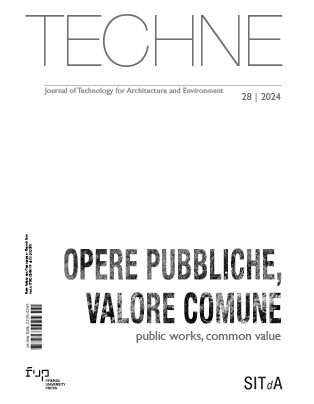Evaluation criteria for a systemic approach to flood risk management: stakeholders’ perspectives
Published 2024-10-29
Keywords
- flood risk management,
- system approach,
- multi-criteria,
- Built environment,
- multi-scalar
How to Cite
Copyright (c) 2024 Francesca Vanelli, Monica Lavagna, Paul Minifie

This work is licensed under a Creative Commons Attribution 4.0 International License.
Funding data
-
Horizon 2020
Grant numbers 101034328
Abstract
Flood risk management authorities rely on structural engineering measures centralised at the spatial and governance levels. These are mainly evaluated based on damage reduction without considering social, economic and environmental criteria. The research proposes an evaluative and procedural methodology to support the choice of spatially distributed measures. After illustrating the research project and the applied methodology, the paper focuses on the first methodological step, which involves identifying multi-scalar and multidisciplinary evaluative criteria through a systematic literature review and interviews. The paper concludes by presenting the criteria, reflecting on the topic and the subsequent developments of the research.
Downloads
References
- Adedeji, T., Proverbs, D., Xiao, H. and Oladokun, V.O. (2024), “The evolution of flood risk management strategies and the role of property flood resilience: Current research trends and directions”, in Lamond, J., Proverbs, D., and Bhattacharya N. (Eds), Research Handbook on Flood Risk Management, Edward Elgar Publishing, pp. 132-142. Available at: https://doi.org/10.4337/9781839102981.00017. DOI: https://doi.org/10.4337/9781839102981.00017
- Alves, A., Gersonius, B., Kapelan, Z., Vojinovic, Z. and Sanchez, A. (2019), “Assessing the Co-Benefits of green-blue-grey infrastructure for sustainable urban flood risk management”, Journal of Environmental Management, Vol. 239, pp. 244-254. Available at: https://doi.org/10.1016/j.jenvman.2019.03.036. DOI: https://doi.org/10.1016/j.jenvman.2019.03.036
- Alves, A., Patiño Gómez, J., Vojinovic, Z., Sánchez, A. and Weesakul, S. (2018), “Combining Co-Benefits and Stakeholders Perceptions into Green Infrastructure Selection for Flood Risk Reduction”, Environments, Vol. 5, n. 2, p. 29. Available at: https://doi.org/10.3390/environments5020029. DOI: https://doi.org/10.3390/environments5020029
- Barendrecht, M. H., Sairam, N., Cumiskey, L., Metin, A. D., Holz, F., Priest, S. J. and Kreibich, H. (2020), “Needed: A systems approach to improve flood risk mitigation through private precautionary measures”, Water Security, vol. 11, 100080. Available at: https://doi.org/10.1016/j.wasec.2020.100080. DOI: https://doi.org/10.1016/j.wasec.2020.100080
- Barquet, K. and Cumiskey, L. (2018), “Using participatory Multi-Criteria Assessments for assessing disaster risk reduction measures”, Coastal Engineering, Vol 134, pp. 93-102. Avialable at: https://doi.org/10.1016/j.coastaleng.2017.08.006. DOI: https://doi.org/10.1016/j.coastaleng.2017.08.006
- Berteni, F., Leoni, P., Pezzagno, M., Piro, P. and Grossi, G. (2020), “Confronto di Criteri di invarianza idraulica e idrologica applicati in Emilia-Romagna e Lombardia”, XXVII Convegno Nazionale di Idraulica e Costruzioni Idrauliche, Reggio Calabria, September 7-9, 2020. Available at: https://hdl.handle.net/11379/545977 (Accessed on 10/06/2024).
- Busi, R. (2018), Suolo, terreno, acqua ed ecosistema nel Piano regolatore, Legislazione Tecnica.
- Dieperink, C., Hegger, D.L.T., Bakker, M.H.N., Kundzewicz, Z.W., Green, C. and Driessen, P.P.J. (2016), “Recurrent Governance Challenges in the Implementation and Alignment of Flood Risk Management Strategies: A Review”, Water Resources Management, Vol. 30, n. 13, pp. 4467-4481. Available at: https://doi.org/10.1007/s11269-016-1491-7. DOI: https://doi.org/10.1007/s11269-016-1491-7
- European Commission (2007), Directive 2007/60/EC of the European Parliament and of the Council of 23 October 2007 on the assessment and management of flood risks. Available at: https://eur-lex.europa.eu/legal-content/EN/TXT/?uri=CELEX:32007L0060 (Accessed on 10/06/2024).
- Hartmann, T., Slavíková, L. and Wilkinson, M. (2022), Spatial Flood Risk Management, Edward Elgar Publishing. Available at: https://doi.org/10.4337/9781800379534. DOI: https://doi.org/10.4337/9781800379534.00021
- Hegger, D.L.T., Driessen, P.P.J., Dieperink, C., Wiering, M., Raadgever, G.T.T. and van Rijswick, H.F.M.W. (2014), “Assessing Stability and Dynamics in Flood Risk Governance: An Empirically Illustrated Research Approach”, Water Resources Management, vol. 28, n. 12, pp. 4127-4142. Available at: https://doi.org/10.1007/s11269-014-0732-x. DOI: https://doi.org/10.1007/s11269-014-0732-x
- Ishiwatari, M. (2024), “Strategic governance – The challenges of integrated flood risk management”, in Lamond, J., Proverbs, D., and Bhattacharya N. (Eds), Research Handbook on Flood Risk Management, Edward Elgar Publishing, pp. 291-303. Available at: https://doi.org/10.4337/9781839102981.00030. DOI: https://doi.org/10.4337/9781839102981.00030
- Kreibich, H., Bubeck, P., Van Vliet, M. and De Moel, H. (2015), “A review of damage-reducing measures to manage fluvial flood risks in a changing climate”, Mitigation and Adaptation Strategies for Global Change, vol. 20, n. 6, pp. 967-989. Available at: https://doi.org/10.1007/s11027-014-9629-5. DOI: https://doi.org/10.1007/s11027-014-9629-5
- Legge Regionale 4 (2016), Revisione della normativa regionale in materia di difesa del suolo, di prevenzione e mitigazione del rischio idrogeologico e di gestione dei corsi d’acqua. Available at: https://normelombardia.consiglio.regione.lombardia.it/NormeLombardia/Accessibile/main.aspx?exp_coll=lr002016031500004&view=showdoc&iddoc=lr002016031500004&selnode=lr002016031500004 (Accessed on 10/06/2024).
- O’Donnell, E., Dolman, N., Everett, G., Kapetas, L., Ncube, S. and Thorne, C. (2024), “Managing flood risk in Blue-Green Cities”, in Lamond, J., Proverbs, D., and Bhattacharya N. (Eds.), Research Handbook on Flood Risk Management, Edward Elgar Publishing, pp. 97-111. Available at: https://doi.org/10.4337/9781839102981.00015. DOI: https://doi.org/10.4337/9781839102981.00015
- Proverbs, D., Lamond, J., Bhattacharya Mis, N. and Rose, C. (2024), “Future research directions for flood risk management”, in Lamond, J., Proverbs, D., and Bhattacharya N. (Eds), Research Handbook on Flood Risk Management, Edward Elgar Publishing, pp. 364-371. Available at: https://doi.org/10.4337/9781839102981.00035. DOI: https://doi.org/10.4337/9781839102981.00035
- Quyên, Đ.T.N. (2014), “Developing University Governance Indicators and their Weighting System Using a Modified Delphi Method”, Procedia – Social and Behavioral Sciences, Vol.141, pp. 828-833. Available at: https://doi.org/10.1016/j.sbspro.2014.05.144. DOI: https://doi.org/10.1016/j.sbspro.2014.05.144
- Raikes, J., Smith, T.F., Jacobson, C. and Baldwin, C. (2019), “Pre-disaster planning and preparedness for floods and droughts: A systematic review”, International Journal of Disaster Risk Reduction, Vol.38, 101207. Available at: https://doi.org/10.1016/j.ijdrr.2019.101207 (Accessed on 10/06/2024). DOI: https://doi.org/10.1016/j.ijdrr.2019.101207
- Regione Lombardia and ERSAF (2017), Progetto Strategico di Sottobacino del Torrente Seveso. Available at: https://www.contrattidifiume.it/it/progetti/progetto-di-sottobacino-seveso/ (Accessed on 10/06/2024).
- Rehan, B. M. (2018), “An innovative micro-scale approach for vulnerability and flood risk assessment with the application to property-level protection adoptions”, Natural Hazards, Vol. 91, n. 3, pp. 1039-1057. Available at: https://doi.org/10.1007/s11069-018-3175-5. DOI: https://doi.org/10.1007/s11069-018-3175-5
- Veerbeek, W., Ashley, R. M., Zevenbergen, C., Rijke, J. and Gersonius, B. (2012), “Building adaptive capacity for flood proofing in urban areas through synergistic interventions”, 7th International Conference on water sensitive urban design, Melbourne, February 21-23, 2012, Melbourne Cricket Ground, pp. 127-134. Engineers Australia. Available at: https://search.informit.org/doi/10.3316/INFORMIT.827293532632171 (Accessed on 10/06/2024).
- Vitale, C. and Meijerink, S. (2021), “Understanding Inter-Municipal Conflict and Cooperation on Flood Risk Policies for the Metropolitan City of Milan”, Water Alternatives, Vol.14, n.2, pp. 597-618. Available at: https://doaj.org/article/fe44293b600845728e240c7178589c88.






